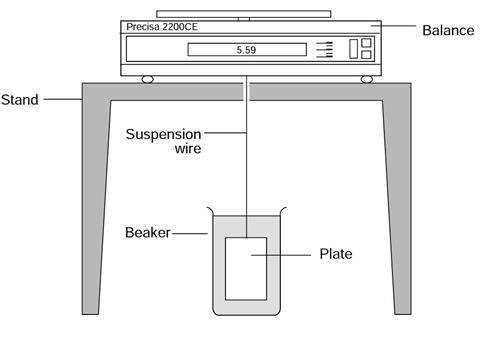Create tin iodide in this practical that explores the rate expression for this compound
Design and carry out an experiment to measure the rate at which tin reacts with iodine.
Equipment
Materials per group
- Tin foil (0.5–1.0 mm thick) as a rectangle 10 mm x 25 mm or 3 g tin cast in the form of discs or cylinders
- Propanol-1-ol for cleaning the surface of the tin
- Iodine in methylbenzene solution, 20 cm3 of 10% w/v
- Methylbenzene for diluting the solution above to give 10 cm3 samples of lower concentrations. (The suggested range is 10% to ca 2% iodine in methylbenzene.)
Equipment per group
- Ignition tube or boiling tube for casting tin
- Beaker or weighing pot without lid, tall narrow 25 cm3
- Balance with underweighing facility reading to ±0.001 g
- Fine emery paper
- Safety glasses
- Gloves
- Access to a fume cupboard
Health, safety and technical notes
- Read our standard health and safety guidance here.
- Eye protection must be worn.
- Methylbenzene must be used in a fume cupboard.
- This is an open-ended problem-solving activity, so the guidance given here is necessarily incomplete.
Commentary
Tin reacts relatively easily at room temperature with a solution of iodine in methylbenzene.
The experiment should prove instructive because the students can observe the progress of the reaction directly. A balance is arranged so that it can weigh a disc or cylinder of tin hanging suspended in an iodine solution.
The balance reading falls steadily with time. The procedure is repeated with different concentrations of iodine; the results should show first order behaviour.
Rate of loss of tin = k[I2]
It is most important that the surface of the tin be cleaned immediately before each run. It should be rubbed carefully with fine emery paper lubricated with water, rinsed with deionised water and finally rinsed with propan-1-ol. After cleaning, the surface should not be touched.
This experiment is described in an earlier Royal Society of Chemistry publication. Since then, the design of balances available for use in schools and colleges has changed, and it has become possible to connect a computer to the balance and use it to process the data.
Procedure
The simplest option is to use tin foil. This needs to be thick enough to allow the surface to be thoroughly cleaned with emery paper before each experiment. Although the heavier gauge foil is more expensive, it is possible to clean and to reuse a sample many times. If the reaction does not work, the most probable reason is that the tin is not clean enough. The reaction with insufficiently cleaned tin takes 12 h, but with clean tin readings can be taken every minute. The alternative method is to cast tin into a suitable shape. There are two ways of doing this:
- Some tin is melted in an ignition tube, and the drops are pushed together with a glass rod. When the tin has solidified, the tube is cracked by immersing it in cold water. A small hole is drilled through the end of the tin bar so that it can be suspended from the balance arm by a monofilament nylon thread. The surface of the tin should be smoothed with fine emery paper and rinsed with alcohol.
- A bar of tin, about 15 mm in diameter, is cast in a glass boiling tube.3 The tin bar is cut into discs about 1 mm thick using a small hacksaw or on a lathe. Small holes are drilled through the discs, which are then smoothed with fine emery paper and rinsed in alcohol. Monofilament nylon thread is then used to suspend the discs.
It is necessary to raise the balance to use the underweighing facility, as shown in the diagram below.

A 10% w/v solution of iodine in methylbenzene is recommended for the first reaction. This can be diluted to give varying concentrations down to 2%. It should be possible to obtain a set of readings within 20 minutes.
Extension
Interfacing a digital balance to a computer has become a standard procedure. This experiment lends itself to this approach; the experimental data can then be printed out in the form of graphs. The experiment could be the basis of more detailed studies on heterogeneous systems If tin foil is available, the effect of varying the surface area could be studied.
Notes
This resource is part of a collection of problem-solving activities, designed to engage learners in small group work. Find out how to use these resources, and obtain a list of suggested ‘junk items’ here.
Downloads
Finding the rate expression for the reaction between iodine and tin
Experiment | PDF, Size 87.1 kb
Additional information
The resources were originally published in the book In Search of More Solutions.


















No comments yet